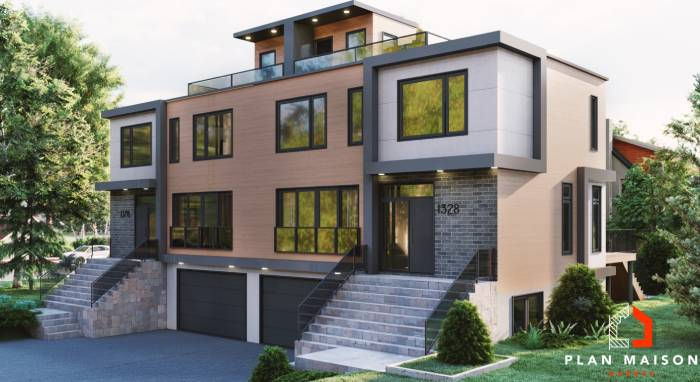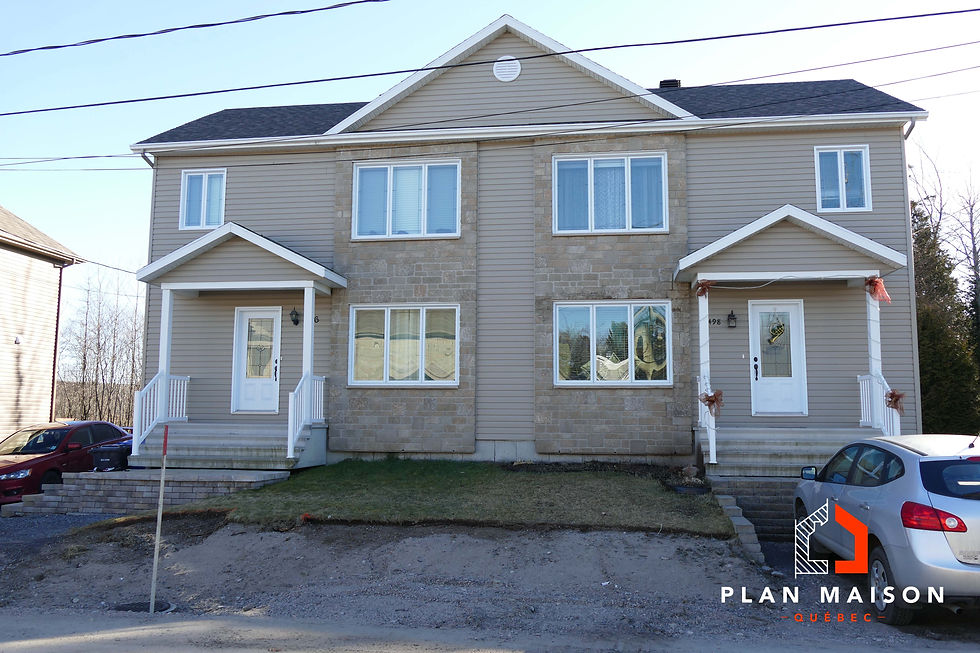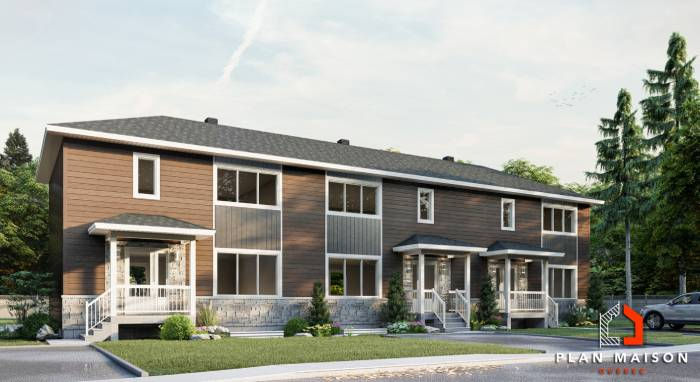Semi-detached and multi-unit houses: what to know?
- coraliefortin076
- Jun 30
- 6 min read
Updated: Jul 21

In Quebec, the residential construction sector is evolving rapidly, with growing interest in housing models that combine affordability, profitability, and efficiency. Among the most popular options are semi-detached homes and multi-unit projects.
Whether you're an individual looking for a new home or an investor looking to maximize your real estate return, it's essential to understand the nuances between these two types of construction. At Plan Maison Québec, our mission is to support you every step of the way, offering customized plans for a house or building perfectly suited to your needs.
Understanding the semi-detached house: a compromise between autonomy and economy
Which option to choose: semi-detached house or multi-unit dwelling?
Characteristics of the architecture of semi-detached houses and multi-unit housing projects
Semi-detached house architecture: efficiency and conviviality
Multi-housing architecture: maximizing space and profitability
Understanding the semi-detached house: a compromise between autonomy and economy
A semi-detached house, also known as a semi-detached house, consists of two housing units built side by side and sharing a common wall. Each has its own entrance, courtyard, and often a detached garage. This type of housing is ideal for those who want to become homeowners without the high costs associated with a single-family home.

The concrete advantages of the semi-detached house
In terms of value for money, the semi-detached house offers a favorable price-performance ratio. It offers access to a new construction with features similar to those of a single-family home, but at a lower cost. This is due to the shared use of certain building components, such as the foundations and the common wall.
At Plan Maison Québec, we have designed numerous semi-detached house models that optimize space and promote abundant natural light, often sought after in this type of housing. In addition to their cost-effectiveness, semi-detached houses offer greater energy efficiency. The shared wall helps limit heat loss, which is particularly valuable during Quebec winters.
Another important point: maintenance tasks are often less demanding. With a smaller lot, gardening, mowing, and snow removal become simpler and faster, a strong selling point for young families or active retirees.

Potential drawbacks to anticipate
However, proximity to the immediate neighbor can pose certain constraints. If soundproofing is not optimal, noise pollution can occur. This is why Plan Maison Québec places particular importance on the quality of materials and the layout of rooms to minimize inconvenience.

Additionally, while semi-detached homes are more private than condos, they offer less freedom in terms of outdoor space than a fully detached home. It's therefore essential to carefully consider your green space or backyard needs before making your choice.
Multi-housing: a profitable real estate strategy
A multi-unit residential building (MUD) combines several dwellings under one roof. Intended for rental or sale, this type of construction has become a popular option for real estate investors in Quebec, especially in urban centers like Quebec City, Lévis, and Sherbrooke.
Why invest in a multi-unit property?
The primary advantage of multi-unit housing is its profitability. By building multiple units on the same plot of land, investors can generate multiple sources of rental income while reducing the average cost per unit. This allows for a faster return on investment, especially if the occupancy rate remains high.

Furthermore, rental demand is strong in several regions of Quebec, particularly among students, young professionals, and single-parent families. Multi-unit housing is therefore a suitable response to this demographic reality.
Another notable advantage is the increased value of the land. By optimizing available space, particularly through vertical development (two- or three-story buildings), the developer significantly increases the value of the property, which can prove very strategic in the long term.
The financial realities of multi-housing in Quebec
However, building a multi-unit building represents a significant initial investment. On average, the cost of building a home is estimated at approximately $70,000 to $100,000, depending on the size of the project, the materials chosen, the architectural design, and the location. At Plan Maison Québec, we support our clients from the design phase to maximize every dollar invested. Our plans are designed to minimize costs without sacrificing quality or durability.
It's also important to consider additional costs:
building permits
professional services (engineers, architects)
taxes
financing costs.

A good business plan and feasibility study are therefore essential. Our team can help you put these documents in place from the very beginning.
Which option to choose: semi-detached house or multi-unit dwelling?
The choice between a semi-detached house and a multi-unit dwelling depends primarily on your profile and your goals. If you're looking for an affordable, independent family home, a semi-detached house is an ideal solution. It combines comfort, privacy, and cost savings, while remaining more accessible than a single-family home.
If, on the other hand, you want to grow your real estate assets or generate passive income, a multi-unit dwelling is an excellent financial lever. It offers numerous optimization possibilities and is perfectly suited to a long-term investment approach.
The environment in which you plan to build is also worth considering. In suburban and semi-urban areas, semi-detached houses are often better accepted by municipal regulations. In dense urban areas, multi-unit dwellings are sometimes favored to meet the growing demand for housing.

Characteristics of the architecture of semi-detached houses and multi-unit housing projects
Architecture plays a fundamental role in the success of a real estate project, whether it's a semi-detached house or a multi-unit development. Architectural choices influence not only the aesthetic appearance of the building, but also its functionality, durability, and integration into the urban or rural environment. At Plan Maison Québec, we make it a point of honor to design projects that combine style, practicality, and compliance with standards.
Semi-detached house architecture: efficiency and conviviality
The architecture of a semi-detached house is based on optimizing space while preserving a certain independence for each unit. This translates into thoughtful interior layouts, with open spaces to maximize natural light while ensuring clear separation between units.
The exterior design of semi-detached houses is often characterized by clean lines and durable materials. The choice of materials can vary, but the following are often favored:
gable roofs
brick or vinyl siding
large windows that provide light and ventilation.
Semi-detached houses must also meet the practical needs of residents, offering functional spaces and fluid circulation, while respecting the occupants' privacy through innovative solutions for common walls.

Multi-housing architecture: maximizing space and profitability
In a multi-unit project, architecture plays a crucial role in space management while promoting optimal profitability. The major challenge lies in designing a building that offers a large capacity while being aesthetically pleasing and functional.
Multi-unit buildings are often designed to maximize land use by building upwards. Additional floors allow for multiple units, while maintaining sufficient spacing between each unit to ensure comfort and privacy. Apartments are designed to benefit from the natural circulation of light, with private balconies, shared green spaces, and communal areas such as spacious entrance lobbies and children's play areas.

Architectural choices in multi-unit projects also include elements such as modern facades with innovative materials such as concrete, steel, or glass, which guarantee durability, safety, and thermal and sound insulation. Furthermore, sustainability is becoming an important criterion, with the adoption of building systems that comply with strict ecological standards, allowing for reduced energy costs and increased long-term property value.
How Plan Maison Québec supports you in your project
At Plan Maison Québec, we understand that every project is unique. Whether you're planning to build a semi-detached home or are an investor looking to develop a profitable multi-unit development, we offer a fully customized residential plan design service.
Our team of architectural technologists is thoroughly familiar with Quebec's municipal regulations and regional specificities. We help you optimize your spaces, comply with construction standards, and maximize the value of your investment. We use state-of-the-art tools to produce professional, detailed, and compliant plans, ready to be used for permit applications and construction.

Our service doesn't end with the delivery of the plan. We remain available to advise you throughout the process: modifications, adjustments, recommendations from construction professionals, etc. Our goal is simple: to make your project a success, from the first sketch to its complete implementation.
Conclusion : Team up with Plan Maison Québec to build your future
Semi-detached homes and multi-unit housing are two smart options that meet different but complementary needs. One offers an accessible and welcoming solution for a comfortable home, while the other represents a solid investment opportunity in a rapidly changing market. Whatever your choice, Plan Maison Québec is here to guide you with expertise and professionalism.
Together, let's bring your house or apartment building project to life, ensuring a well-thought-out, functional plan, tailored to your goals.



Comments